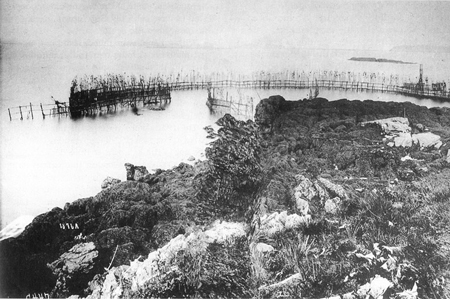B A C K T H E N
Passamaquoddy Bay Fish Weir

Photo courtesy of T.W. Smillie; National Archives
A Passamaquoddy Bay fish weir, built of white birch stakes and brush, about 1880. This is a “shore” weir as distinguished from a “bar,” “channel,” or “patent” weir. It is a herring weir, not a salmon, shad, alewife, or sturgeon weir, or any other type of weir or pound net constructed along the eastern seaboard. Once a major source of fish, weir fishing is now extinct.
Weirs were first built in the Eastport area about 1820 for the purpose of obtaining fish for the smoked-herring business. The predominant method of fishing, however, continued to be night time torching and dip-netting. The growth of weir fishing came with the rise of the sardine business, and, by 1893, 240 weirs were in use in or near Passamaquoddy Bay. Most were likely in New Brunswick waters.
The three most important considerations when locating a weir were location, location, and location. The best locations featured strong tidal currents, since the plankton-feeding herring usually entrapped themselves while slowly stemming the current. Ideally, a weir opened towards the west, since the fish often swam towards the rising sun. Fish within a weir respected the brush fence, although they easily could have swum through it. The weir pocket was closed off by a gate, and was usually “fished” by means of a seine. Herring were then dip-netted into a caraway boat.
Weir building spread up the coast, and weirs became a major source of bait fish. Questions regarding rights to weir locations occasionally ended up in the courts. As was the sardine business in general, weir fishing was usually a matter of feast or famine.
The steamer at far right, a former pogy boat, both carries fish and tows caraway boats.
Text by William H. Bunting from A Day’s Work, A Sampler of Historic Maine Photographs, 1860-1920, Part I. Published by Tilbury House Publishers, Gardiner, Maine, 800-582-1899.
